Erika Wastrom’s paintings depict uncanny worlds that seem equal parts imagined and observed. Despite recognizable elements — a shopping cart, a child’s sippy cup — there is a playful oddity about her pictures, something unfamiliar and unexpected.
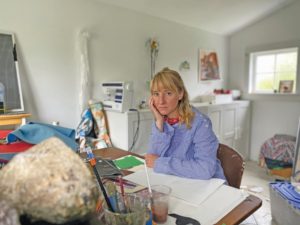
“It’s very strange to be a human, with all our stuff,” says Wastrom, whose paintings focus on people and their relationships to each other — and to things. “I search out those moments in our lives where I feel that strangeness.”
In one painting currently on view in a group show at GAA Gallery, a woman kneels awkwardly with a pair of scissors. It was inspired by a person cutting weeds who Wastrom saw while she was driving.
“It seemed otherworldly,” says the artist. “Her pose was more like an animal than a human.” In the painting, Wastrom captures her subject in the act of cutting — but what she observed as plants look more like large balloons hovering over the figure.
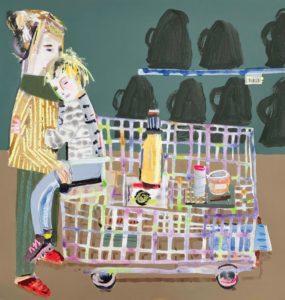
As in life, where glimpses of the peculiar peek through everyday routines, painting is like a “magical place” where the known and unknown coalesce: “Anything can happen in a painting,” says Wastrom. Although her works typically begin as a response to something observed, odd things happen: a plant can turn into a balloon, or a figure can bend herself into an impossible pose. “It’s really about just being present with the paintings, because I want them to surprise me,” she says.
There’s a sense of discovery in Wastrom’s practice, and she’s masterful at mixing materials while speaking different visual languages. Hard edges and precise shapes are combined with fast gestural marks using watercolor and ink. The materials bleed in loose abstracted passages that contrast with flat opaque areas of color achieved by mixing talc powder or chalk with the paint.
Wastrom says she finds inspiration in Brice Marden’s early color field paintings and the way he used flat color paradoxically to evoke a deep, immersive space with an impenetrable surface. Her love of early Italian painting by artists like Sassetta and Fra Angelico is also evident in her use of flattened figures and stacked space, where objects rise upward over the vertical span of the painting.
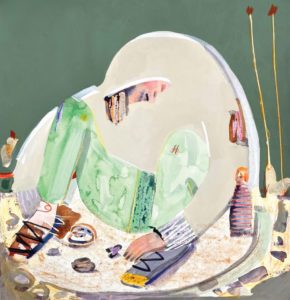
And like those early Renaissance painters, who had only a tentative interest in the physical world, Wastrom has an ambivalent attitude toward materialism. “How do we make sense of these objects?” she asks. “The material plastics, the sentimental objects, the clothes we wear? I constantly have these questions. I don’t think the paintings resolve my questions, but they make them more clear.”
Wastrom grew up in Orleans and studied art with Vicky Tomayko and Jim Peters at the Cape Cod Lighthouse Charter School. She took a figure class at Castle Hill when she was in high school, where she created a portfolio of work for her art school application. Although she left the Cape for college and lived in New Orleans for six months and then Boston for her M.F.A. program, she has returned to live in West Barnstable with her family.
“This isn’t the typical thing to do,” she says, noting that many of her peers moved to the city or devoted themselves to residencies or teaching on the adjunct circuit as a way to gain a professorship. Nonetheless, Wastrom has continued to create ambitious work and show her paintings in well-established galleries.
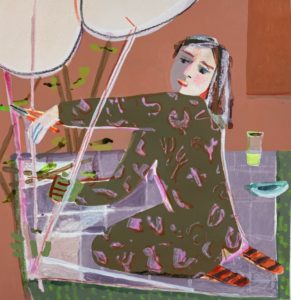
But she doesn’t take herself — or her work — too seriously. “I like the way they’re a little inconsequential,” she says of her paintings. “Everything could float away or fall apart.” She works exclusively on paper because of the way it suggests that “everything is on the edge of becoming something.” It’s also easy to dispose of, which she does frequently if the divergent elements in a composition don’t appear to have “come together in one moment.”
She’s worked on paintings in the bathroom while her kids are taking a bath. Her sons, ages four and seven, sometimes draw on them — and often take over her sketchbooks. “When I talk about my work being inconsequential, it’s because being a mother is the most important thing,” Wastrom says. “Living with two creative geniuses makes me feel not that important.”
She’s aware that this levity is perhaps what makes her work consequential. The diminutive gesture feels especially relevant at this moment in history. Wastrom’s paintings embody a spiritual corrective to a world reeling under the weight of rampant consumerism, bloated egos, and unbridled ambition.
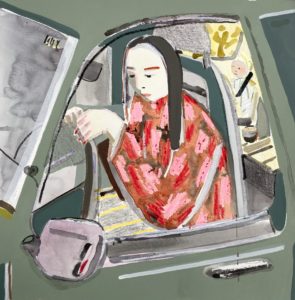
In Wastrom’s work there is a freedom to begin with an idea and end someplace else: to scrawl across a carefully painted section of an image, to prioritize things that aren’t things, like family, or joy. It’s a place where “anything can happen.”
Anything Can Happen
The event: A group exhibition including work by painter Erika Wastrom
The time: Through Nov. 26
The place: GAA Gallery, 494 Commercial St., Provincetown
The cost: Free



